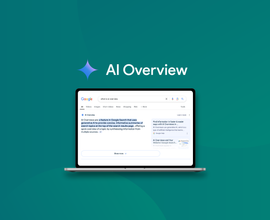The SEO Content Creation Process: A How to Guide
The most crucial part of the content creation process is promoting that content and having it found by your target audience. Even if you have the most compelling design, an interactive experience and great story, they’re all for naught if your audience isn’t able to find and consume your content.
That is why SEO shouldn’t just have a place at the content creation table; it should be embedded into the entire process. And that’s starting at the very beginning.
Changing the way your team approaches content creation can feel a bit daunting. But we’ve found when you bring together all key stakeholders from the beginning--including SEO--everyone works together better and creates an overall better product.
Take the following steps to establish a repeatable SEO content creation process built for success.
Step 1: SEO Team Structure
It all starts with bringing your SEOs and designers into the fold from the beginning. Before even kicking off a project, it’s essential to define your team, establish each member’s contributions and determine who your key stakeholders are.
We recommend the following team structure to ensure all the appropriate perspectives are represented:
- SEO experts provide keyword research and help you ideate with the customer’s voice, questions and needs top of mind. They provide insights for meta descriptions and H tags. They provide insight into the type of content your competitors have already published, so you can add new value to the conversation.
- Copywriters provide support in the outline and ideation phases. They also offer the wordsmithing necessary to craft a compelling story and call to action, so you can see tangible success from your content investments.
- Designers/Developers help transform an idea into an experience. They break down the story and reimagine it so your audience stays engaged.
- Digital Marketers express content needs for their campaigns and develop strategies for distribution.
Step 2: SEO & Digital Marketing Goals
Define your project goals at the beginning. This allows you to craft your content more strategically based on the outcomes you want to achieve. And because you’ve included all important team members from the beginning, you’ll be able to get their input on goals. At this step, think about the audience you want to reach. What they are searching for? How can you help answer their questions? What type of content would they consider “relevant” and “compelling”? What, specifically, do you need them to do next? Document these objectives and align them to your goals to help measure your performance.
Example: Your marketing goal may be lead generation. If your SEO is involved early on, they can identify opportunities to help your page capture an answer box or rank for a particular query to drive more organic traffic and help meet your goal.
SEO specific goals:
- Rank on page 1 for specific keywords
- Capture answerbox
- Outrank competitors on priority keyword(s)
Digital Marketing goals:
- MQLs / SQLs
- Conversions
- Impressions
- CTRs
Step 3: Kickoff Meeting
After you’ve defined your team and identified your goals, it’s time to gather to brief and scope your project. At this kickoff meeting, you will:
- Outline your key objectives
- Define your target audience
- Establish your message
- Set your timeline
At Conductor, we have found these meetings to be helpful in both recognizing potential roadblocks and identifying areas of opportunity to integrate and cross-promote content.
Step 4: Content Brainstorming & Development
A good team brainstorm is one of the most important parts of the content creation process. You will see an instant change in the quality and creativity of your projects when you take this fun and collaborative step.
Here are some tips to support good, productive brainstorming sessions:
Share briefingBriefing
A briefing is a short meeting or an introduction to a new topic. It is mainly used in the areas of military, aviation and diving as well as in online marketing and advertising.
Learn more doc in advance. Allow team members to ruminate on the audience and goals and come to the meeting with ideas and examples.
Set up space for creativity. Whether in person or remote, provide resources like whiteboards or digital mood boards to stimulate collaboration.
Establish creative direction and content format. Once the team has come to an agreement around content format and creative approach, outline next steps, including individual responsibilities, deadlines and goal launch date.
Step 5: Content Brief
Now it’s time for your copywriter and SEO to collaborate on a content brief. Include your briefing doc and takeaways from the brainstorm meeting so all collaborators have access to goals, audience and timeline. Your copywriter will put together an outline with relevant background information and resources, and your SEO will put together title suggestions, meta descriptionMeta Description
The meta description is one of a web page’s meta tags. With this meta information, webmasters can briefly sketch out the content and quality of a web page.
Learn more, H2 suggestions and keywordKeyword
A keyword is what users write into a search engine when they want to find something specific.
Learn more recommendations.
How to Conduct Keyword Research
- Create a list of keywords relevant to your business.
- Bucket these based on keyword intent across buyer’s journey stages.
- Find latent semantic indexing (LSI) keywords.
- Conduct competitive keyword research.
- Check SERP rankings.
How to put together an SEO Content Brief
- Conduct keyword research and competitive analysis:
- Are my top competitors ranking well for the topic I want to write about? If so, how have they structured their content? The Conductor for Chrome browser extension can provide insight into competitors’ strategies, help you discover gaps and find new ways to serve your target audience.
- Identify target keywords for the content you want to create:
- Highlight the primary, secondary and even tertiary keywords you will use throughout the body copy.
- Use Conductor to create a content brief. Some key points to include are:
- Include Title Tag, Meta Description, H1 and other heading tags
- Suggested URL
- Target Keywords (based on your prior keyword research)
- Top questions to answer (What is my target audience looking for?)
- Reference pages, including related competitor content
- Details on target audience and tone to ensure the entire team is aligned on approach with the overall marketing strategy
- Share the content brief via Google Docs (or your preferred collaboration platform) with the wider team
If you’re a Conductor user, you can streamline this entire process by creating Content Briefs directly in the platform and share with team members via your task management and collaboration tools, such as Asana, Trello and Jira.
Step 6: Content & Design Collaboration
Collaboration is at the core of creating successful content. In the new era of content marketingContent Marketing
Content marketing is a marketing discipline with the goal of increasing awareness and scope for products and brands in the desired target group with content published on the web and offline.
Learn more, we believe that copywriters should just be focusing on the narrative; they should be thinking about the overarching story being created, and that includes design. They should think about UX as much as they think about SEO and word choice.
Writing and preliminary design concepts (called wireframes) should be done in tandem, with one informing the other. While the copywriter and designer work on their tasks, they should work closely with each other to make sure the direction and copy length fit within the wireframeFrame
Frames can be laid down in HTML code to create clear structures for a website’s content.
Learn more, add new elements such as side bars and data visualizations, and adjust the flow accordingly.
As designers build out the final piece of content based on the established wireframe, it is essential that the collaboration with the copywriters continues to ensure the content flows well in the overall design experience.
Step 7: Content Review & Distribution
A thorough review cycle is essential to a seamless launch. Before publishing your content, make certain you’ve executed the items on the checklist below.
- Set up staging. This will allow you to preview your live content and make design adjustments.
- Copy edit. Enlist the review support of someone other than the copywriter who composed the content for a fresh set of eyes.
- Design review. Check your rendering on desktop, mobile and in a variety of browsers.
- SEO review. Ensure your meta description and all header tags are accounted for. Ensure all of your images have alt text.
- Review SEO best practices ensuring:
- Target keyword is included at the beginning of the Title & H1 tag
- Primary, secondary, and tertiary keywords are woven into the body copy throughout the page naturally (to avoid keyword stuffing)
- Include internal links to ensure it is not an orphan page
- Ensure canonical tag is set for the page
- Ensure all images have alt text
Congratulations! You’re ready to publish!
Step 8: SEO Measurement
You can’t determine the success of a piece of content until you monitor its engagement. Revisit your briefing document to evaluate your goals and benchmark your performance. Set up a timeline for reporting and team review cycles. And of course, don’t forget to work with your SEO to report on content keyword performance and share wins like capturing answer boxes and outranking competitors.
If you’re using an enterprise SEO platform, you should have one-click access to meaningful data that helps you understand the performance of your content across key channels. By communicating and collaborating consistently with your SEO, you can maximize reach and visibility of your content, and drive maximum value from your marketing and SEO investments. Not to mention, you can use these metrics with executive leadership to demonstrate the positive impact your team is making.
Step 9: SEO Optimizations & Refinement
The final and ongoing step in your content creation process is refinement. Refining your content will depend on the insights you are able to glean from evaluating its performance. This includes making adjustments to your headline, H2 tags or keywords based on performance metrics.
Search engines and social media platforms are swarming with great content. While it’s more important than ever for your brand to stand out, the most critical first step in that process is getting found. To keep pace in this hyper-competitive world of marketing, content creation is more efficient and effective for the entire business when content, web, design and SEO experts work together from the beginning.







